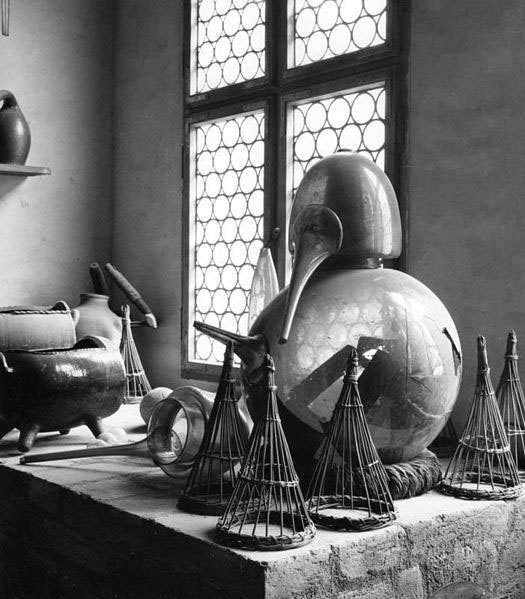IN THE SHADOW OF THE SPIRE
Session 10C: Back to the Labyrinths
Opening the box of cherry wood they found a manuscript entitled Observations of Alchemical Reductions and the Deductions Thereof by Master Alchemist Tirnet Kal. The book seemed untouched by age, and Ranthir was immediately enthralled – this had once been a well-known alchemical text, but the last copy of it was thought to have been lost several centuries ago.
Treasure is something I left under-utilized in my games for years: Looting X number of gold pieces and maybe some magic items was simply de rigueur. And, honestly, the psychological pleasure of an escalating numerical value (particularly as it counts its way towards the anticipated acquisition which it makes possible) shouldn’t be undervalued.
But as I mentioned in Getting the Players to Care the Golden Rule of Gaming is that players pay attention when you describe treasure. So if the only thing you’re offering to that undivided attention is generic numbers, you are wasting a golden opportunity.
(I may be gilding the lily here with all these gold puns.)
What you want to do is create treasure which contains meaning; which has specific, creative content. The Observations of the Alchemical Reductions and the Deductions Thereof are one example of that. (Saying that there are “rare books” worth X number of gold pieces is more interesting than simply a sack of gold; specifically listing what these books are is more interesting yet.)
At its most basic level, such treasure increases the player’s immersion and interaction with the game world. But you can use this to additional effect:
- As with the Observations, such treasure can reward character skill (or player insight) by making the treasure more valuable than it first appears. This creates an additional layer of arguably more meaningful reward.
- As described in Getting the Players to Care, treasure can be used to package exposition into an attractive and memorable package for the players.
Simply providing intriguing chaff – little bits of random “cool” that have no purpose or intended greater meaning, like Tolkien’s reference to the cats of Queen Berúthiel – are nonetheless valuable because they provide texture to the improvisational texture of the game world. You can never be entirely sure what uses your players will find for items similar to my 101 Curious Items, or how they’ll combine with other elements of the campaign to create memorable events.
But then Ranthir raised the possibility that they might find a way of transporting the entire orrery to the surface and selling it intact.
The orrery that the PCs also discovered in this section of Ghul’s Labyrinth is an example of this: You’ll see a whole sequence of events spill out over the next few campaign journals which I had no way of anticipating when I created the orrery as a form of nifty and evocative treasure.
The orrery also shows how the context you add to treasure can be used to create obstacles and interesting challenges for the PCs to overcome. One of the most basic ways you can do this – as exemplified by the orrery – is to make the treasure weighty, bulky, or otherwise difficult to transport. Successfully getting the treasure home now becomes part of the challenge. (In the case of the orrery, this took the form of Ranthir’s player eventually coming up with the very clever idea of selling the location of the rarity and letting the buyer of that valuable information deal with the difficulties of transporting it.)
Personalizing this sort of treasure can also be effective. In another D&D campaign, there was a player whose character spent the first ten or so levels stripping dungeons and enemy lairs of interesting pieces of furniture, art, and other accoutrements in order to furnish the fortress-temple he wanted to one day build for his elemental goddess. You can be sure that these features received extra care and attention from me for the duration of that campaign.
Doing so revealed a large room filed with cages of wrought iron. Tee saw that there were age-yellowed skeletons lying in dusty heaps within several of them.
You can also make the creatures the PCs fight a form of treasure in themselves. Pelts, furs, and other animal products have possessed great value throughout history. In the case of this particular session, the creatures were long dead, but there’s no reason the PCs can’t harvest from their own kills.
In setting this up, however, you want to be careful: If you make a particular animal’s carcass too valuable, you will curtail your ability to use that creature ubiquitously.
This can also become an interesting way of complicating combat: You may not be able to fricassee the golden wombat with a fireball if you want to be able to sell its fur, which will limit the tactics you can effectively use while fighting them. (The old school rules for subduing dragons have a similar dynamic.)













Your interior decorator PC reminds me of something that happened one of the few times I was DM. One of the other players liked to play colorful, quirky characters — his main PC was a chaotic neutral halfling rogue who always had his own schemes going on that the other PCs weren’t privy to. I was running a published module where the PCs were exploring an abandoned wizard’s tower, and in one of the rooms there was a wooden scale model of the wizard’s former academy. The player decided his PC was going to fixate on this model, and make a detailed sketch of it. His explanation was that the PC assumed that the design of the structure must possess some arcane power, and wanted to build one for himself someday.